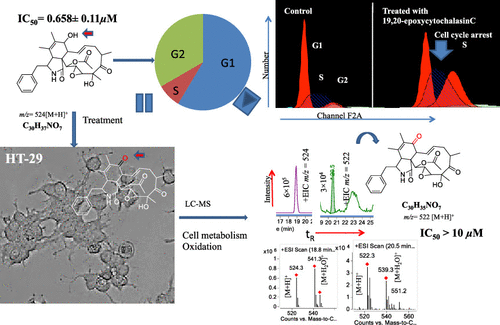Our official English website, www.x-mol.net, welcomes your
feedback! (Note: you will need to create a separate account there.)
Tandem MS-Based Metabolite Profiling of 19,20-Epoxycytochalasin C Reveals the Importance of a Hydroxy Group at the C7 Position for Biological Activity
ACS Omega ( IF 3.7 ) Pub Date : 2021-01-25 , DOI: 10.1021/acsomega.0c05307
Manoj Kushwaha 1, 2 , Arem Qayum 3, 4 , Shreyans K. Jain 5 , Jasvinder Singh 3, 4 , Amit Kumar Srivastava 6 , Shubham Srivastava 7 , Nisha Sharma 1, 4 , Vidushi Abrol 1 , Ruchi Malik 7 , Shashank K. Singh 3 , Ram A. Vishwakarma 8 , Sundeep Jaglan 1, 4
ACS Omega ( IF 3.7 ) Pub Date : 2021-01-25 , DOI: 10.1021/acsomega.0c05307
Manoj Kushwaha 1, 2 , Arem Qayum 3, 4 , Shreyans K. Jain 5 , Jasvinder Singh 3, 4 , Amit Kumar Srivastava 6 , Shubham Srivastava 7 , Nisha Sharma 1, 4 , Vidushi Abrol 1 , Ruchi Malik 7 , Shashank K. Singh 3 , Ram A. Vishwakarma 8 , Sundeep Jaglan 1, 4
Affiliation

|
Seven cytochalasins, 19,20-epoxycytochalasin N, cytochalasin P1, deacetyl 19,20-epoxycytochalasin C, 19,20-epoxycytochalasin D, 19,20-epoxycytochalasin C, cytochalasin D, and cytochalasin C, were isolated from a fungal (Rosellinia sanctae-cruciana) crude extract. A cytotoxicity assay (sulforhodamine B) was performed on a series of cancer cell lines: HT-29, A-549, PC-3, HCT-116, SW-620, and MCF-7. Simultaneously, the liquid chromatography–mass spectrometry (LC–MS)/MS profile of 19,20-epoxycytochalasin C-treated cell lines revealed that 19,20-epoxycytochalasin C (m/z 524.25) oxidized to a metabolite of m/z 522.25 Da (−2 Da (−2H) from 19,20-epoxycytochalasin C). Further chemical oxidation of 19,20-epoxycytochalasin C using the Dess–Martin reagent produced an identical metabolite. It has been noticed that the parent molecule (19,20-epoxycytochalasin C) showed an IC50 of 650 nM (on HT-29), whereas for the oxidized metabolite (m/z 522.24) of 19,20-epoxycytochalasin C, the IC50 was >10 μM. It is clear that the parent molecule had 16 times higher cytotoxic potential as compared to the oxidized metabolite. The spectroscopic investigation indicated that the oxidation of the hydroxyl (−OH) group occurred at the C7 position in 19,20-epoxycyctochalsin C and led to the inactivation of 19,20-epoxycytochalasin C. Further, cell cycle analysis and histopathological evidence support the findings, and CDK2 could be a possible target of 19,20-epoxycyctochalasin C.
中文翻译:

基于串联MS的19,20-环氧细胞松弛素C代谢产物分析揭示了C7位置生物活性的羟基基团的重要性。
七个细胞松弛素,19,20-epoxycytochalasin N,细胞松驰素P1,脱乙酰19,20-epoxycytochalasin C,19,20-epoxycytochalasin d,19,20-epoxycytochalasin C,细胞松驰素d,细胞松弛素和C,从真菌中分离(Rosellinia sanctae -cruciana)粗提物。在一系列癌细胞系HT-29,A-549,PC-3,HCT-116,SW-620和MCF-7上进行了细胞毒性试验(磺胺多巴胺B)。同时,液相色谱-质谱法(LC-MS)/ MS分析了19,20-环氧细胞松弛素C处理的细胞系,发现19,20-环氧细胞松弛素C(m / z 524.25)被氧化为m / z的代谢产物522.25 Da(来自19,20-环氧细胞松弛素C的-2 Da(-2H))。使用Dess-Martin试剂对19,20-环氧细胞松弛素C进行进一步的化学氧化可产生相同的代谢物。已经注意到,母体分子(19,20-环氧细胞松弛素C)的IC 50为650 nM(在HT-29上),而对于19,20-环氧细胞松弛素C的氧化代谢物(m / z 522.24), IC 50> 10μM。显然,母体分子的细胞毒性潜力是氧化代谢产物的16倍。光谱研究表明,羟基(-OH)的氧化发生在19,20-环氧胞苷C中的C7位置,并导致19,20-环氧胞松弛素C失活。此外,细胞周期分析和组织病理学证据支持研究发现,CDK2可能是19,20-环氧环瓜氨酸C的可能靶标。
更新日期:2021-02-09
中文翻译:

基于串联MS的19,20-环氧细胞松弛素C代谢产物分析揭示了C7位置生物活性的羟基基团的重要性。
七个细胞松弛素,19,20-epoxycytochalasin N,细胞松驰素P1,脱乙酰19,20-epoxycytochalasin C,19,20-epoxycytochalasin d,19,20-epoxycytochalasin C,细胞松驰素d,细胞松弛素和C,从真菌中分离(Rosellinia sanctae -cruciana)粗提物。在一系列癌细胞系HT-29,A-549,PC-3,HCT-116,SW-620和MCF-7上进行了细胞毒性试验(磺胺多巴胺B)。同时,液相色谱-质谱法(LC-MS)/ MS分析了19,20-环氧细胞松弛素C处理的细胞系,发现19,20-环氧细胞松弛素C(m / z 524.25)被氧化为m / z的代谢产物522.25 Da(来自19,20-环氧细胞松弛素C的-2 Da(-2H))。使用Dess-Martin试剂对19,20-环氧细胞松弛素C进行进一步的化学氧化可产生相同的代谢物。已经注意到,母体分子(19,20-环氧细胞松弛素C)的IC 50为650 nM(在HT-29上),而对于19,20-环氧细胞松弛素C的氧化代谢物(m / z 522.24), IC 50> 10μM。显然,母体分子的细胞毒性潜力是氧化代谢产物的16倍。光谱研究表明,羟基(-OH)的氧化发生在19,20-环氧胞苷C中的C7位置,并导致19,20-环氧胞松弛素C失活。此外,细胞周期分析和组织病理学证据支持研究发现,CDK2可能是19,20-环氧环瓜氨酸C的可能靶标。

































 京公网安备 11010802027423号
京公网安备 11010802027423号